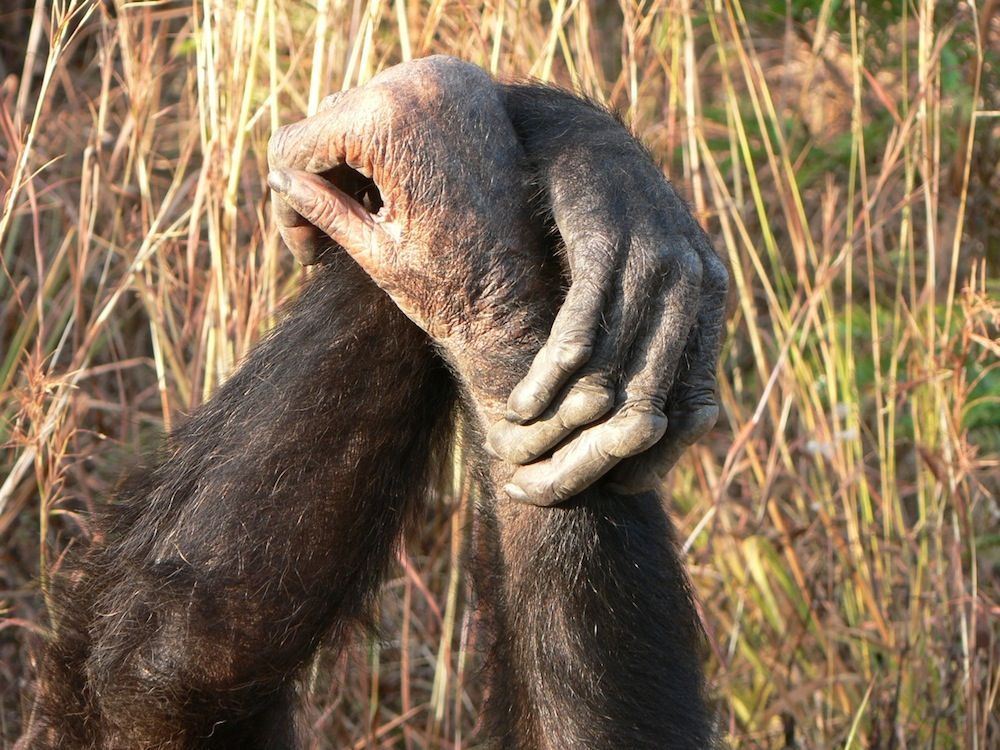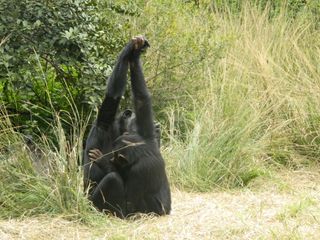Chimp 'Secret Handshakes' May Be Cultural

Chimpanzees that engage in unusual hand-holding behavior during grooming may be showing off a little culture, new research suggests.
These chimp handshakes, which are seen only among some of the primates, seem to differ from group to group in ways that aren't dependent on genetics or environment. That leaves cultural differences between groups as a possible explanation for why and how the hand-holding occurs.
"We think that this at least indicates that chimpanzees do not only respond to their environment instinctively or based on genetic predisposition," said study researcher Edwin van Leeuwen, a doctoral student at the Max Planck Institute for Psycholinguistics in the Netherlands. Nor do they learn in a vacuum, van Leeuwen told LiveScience.
"They can have a shared community tradition," he said.
Handshakes and grooming
Chimps groom to bond, to relax and to get rid of pesky insects. Among some groups, though, the fur-picking is accompanied by above-the-head hand-holding. One chimp will grasp the other's hand and raise their linked hands toward the sky. The apes will then start grooming one another with their free hands. [See Images of the Hand-Holding Chimps]

This behavior was first seen in a group of chimps in Tanzania, and has been observed in at least 15 other groups as well. Meanwhile, some groups of chimps never break out hand clasps during grooming. It hasn't been clear whether the difference is purely social or whether there are genetic or environmental factors that explain it, van Leeuwen said.
Sign up for the Live Science daily newsletter now
Get the world’s most fascinating discoveries delivered straight to your inbox.
At the Chimfunshi Wildlife Orphanage Trust (CWOT) in Zambia, multiple groups of semi-wild chimps live in 50- to 200-acre forest enclosures. About half of these chimpanzees are rescues from the wild, and the other half are born to rescued moms at the Trust. This mix of animals means there aren't major genetic differences between the groups as would be seen in related families in the wild.
The chimps also share the same environment, though they are separated by fences and cannot see one another. That makes them a perfect test case for pegging down the reason for social differences, van Leeuwen said.
Rudimentary culture?
Van Leeuwen and his colleagues observed the chimps for more than 1,000 hours between 2010 and 2012, recording the primates' grooming behaviors. They found that of the four groups at the sanctuary, two never held hands while grooming.
The other two groups were big into hand-clasping, but even here, there were differences. Group 1 almost always grasped their hands palm-to-palm, while Group 2 hooked their wrists around each other instead. Additional observation by sanctuary scientists suggests that these behaviors have been going on for at least nine years. [See video of the chimps grooming]
The researchers have also observed young chimpanzees learning the hand clasps from their elders, van Leeuwen said. About 80 percent of the time, juvenile chimps first practice the hand-grabbing grooming with their mothers, the researchers found.
The fact that the behavior is long-lasting and appears to be passed down through generations suggests that the handshakes may be a rudimentary form of culture, van Leeuwen said. Other studies have found that different groups of chimps use tools differently, suggesting similar cultural differences, but this is the first example of different social interactions between groups, he said.
"The indication might be that chimpanzees have the capacity at least to respond to their environment with more flexibility," van Leeuwen said. "It's social flexibility and that's of course what we definitely see in humans."
The researchers report their work today (Aug. 28) in the journal Proceedings of the Royal Society B.
Follow Stephanie Pappas on Twitter @sipappas or LiveScience @livescience. We're also on Facebook & Google+.

Stephanie Pappas is a contributing writer for Live Science, covering topics ranging from geoscience to archaeology to the human brain and behavior. She was previously a senior writer for Live Science but is now a freelancer based in Denver, Colorado, and regularly contributes to Scientific American and The Monitor, the monthly magazine of the American Psychological Association. Stephanie received a bachelor's degree in psychology from the University of South Carolina and a graduate certificate in science communication from the University of California, Santa Cruz.










